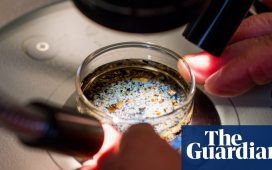It was hailed as the biggest maritime discovery since the Mary Rose was found back in the 1970s.
Now, incredible underwater footage reveals the ‘awe-inspiring’ wreck of royal warship HMS Gloucester, which sank on May 6, 1682 after hitting the Norfolk sandbanks in the southern North Sea.
The ‘outstanding’ ship foundered while carrying the future King of England and Scotland James Stuart, then the Duke of York, who survived at the expense of up to 250 crew and passengers.
Its remains were finally uncovered in 2007, around 28 miles off the coast of Great Yarmouth half-buried on the seabed – but it wasn’t until last year that the discovery was made public.
Artefacts recovered from the wreck – including clothes, shoes, navigational equipment, glass bottles and the ship’s bell – will go on public display for the first time in Norwich from this weekend.

The ‘outstanding’ ship, which sank on May 6, 1682 after hitting the Norfolk sandbanks in the southern North Sea, was uncovered 28 miles off the coast of Great Yarmouth half-buried on the seabed – but the find was kept secret for more than a decade to conserve the ship
HMS Gloucester is now split down the keel and the remains of the hull are submerged in sand, although items including an anchor, rope and cannon are visible in the new film.
The fact Gloucester has been covered and uncovered by sand over hundreds of years is also helping preserve the wreck, while some of the artefacts have been well-preserved due to anaerobic conditions underwater.
Authorities say there are currently no plans to bring any part of the remains to land, but site surveys and almost 7,000 photos taken by the Maritime Archaeology Trust have provided a new 3D image of the full wreck site.
‘The deep water within which the site lies and the low visibility provided challenging conditions for site surveys,’ said Garry Momber, director of Maritime Archaeology Trust.
‘However, every minute spent underwater on such a historically important site was invaluable, allowing us to take almost 7,000 photographs during the diving mission in 2022 to record the wreck in fine detail, and enable the creation of a 3D model.
‘Now the public can see through the murk to the collapsed ship on the seabed and gain an insight into the archaeological potential that remains.
‘Significantly, we can also see the impact of shifting sands that are covering and uncovering different areas of the ship, exposing it to ongoing degradation.’
HMS Gloucester represents an ‘almost’ moment in British political history, as it nearly caused the death of the Catholic heir to the Protestant throne at a time of great political and religious tension.
James Stuart, later James II of England, who would be Britain’s last Catholic king, survived the sinking but up to around 250 sailors and passengers lost their lives, largely due to his actions.
James barely survived, having delayed abandoning ship until the last minute, needlessly costing the lives of between 130 and 250 people on board who, because of protocol, could not abandon the ship before royalty.
The future king denied any responsibility for the loss of life, instead blaming the ship’s captain, James Ayres, who was imprisoned.
The disaster was witnessed by diarist Samuel Pepys, who was on another vessel in the fleet and wrote a harrowing account of victims and survivors being picked up ‘half dead’ from the water.

Artefacts rescued and conserved from the wreck include clothes and shoes, navigational and other professional naval equipment, personal possessions, and many wine bottles. Pictured, Bellarmine bottles, a type of stoneware

The wreck of a royal warship which sank in 1682 while carrying the future King of England James Stuart was discovered off the coast of Norfolk in 2007. Photo shows divers Julian and Lincoln Barnwell measuring a canon that was found with the wreck

New 2D ‘photogrammetry’ image of the full wreck site. Photogrammetry involves analysing and comparing 2D photographs to create a composite

Leather pouch with crown symbols taken from the wreck. The ship itself is fragmented and still on the seafloor, and authorities say there are currently no plans to bring any part of the remains to land

Pictured, glass urine flask from HMS Gloucester. No-one knew the Gloucester’s exact whereabouts until it was found in 2007 by the Barnwells and their friend, retired ex-Royal Navy submariner and diver James Little

In 2012, one of the rescued finds – the ship’s bell, manufactured in 1681 (pictured) – was used by the Receiver of Wreck and Ministry of Defence to conclusively confirm the wreck was the Gloucester

Pictured, a trumpet mouthpiece, broken off from the rest of the instrument. Prior to electronic loud speakers and two-way radios, speaking trumpets served to amplify voices

The 54-gun frigate, which sank on May 6, 1682 after hitting the Norfolk sandbanks in the southern North Sea, was uncovered 28 miles off the coast of Great Yarmouth. The exact location of the wreck is protected and cannot be made public
Efforts to locate the wreck of HMS Gloucester were led by brothers Julian and Lincoln Barnwell, along with their late father Michael and two friends including James Little, a former Royal Navy submariner and diver.
The brothers had decided to hunt for the vessel after reading about it in a book in 2003, but they were beginning to give up hope after four fruitless years.
Finally, efforts proved successful in June 2007 following a four-year search covering 5,000 nautical miles, but the brothers – printers by trade – didn’t disclose their find for 15 years to keep it safe from treasure hunters as it was in international waters.
In 2012, one of the rescued finds – the ship’s bell, manufactured in 1681 – was used by the Receiver of Wreck and Ministry of Defence to conclusively confirm the wreck was the Gloucester.
‘We’re delighted to be able to share these glimpses of the wreck site, more of which visitors will be able to see in the exhibition, and excited to share the rescued artefacts for the first time with the public,’ Lincoln said.
‘The footage also highlights how vulnerable the wreck is, with fishing nets visible, and artefacts exposed on the surface of the seabed.
‘This dynamic wreck site is clearly “at risk” and there is a real urgency to secure the heritage of the Gloucester and the connected artefacts.’
Professor Claire Jowitt, a maritime history expert at the University of East Anglia, has called HMS Gloucester the most important maritime discovery since the Mary Rose, the warship from the Tudor navy of King Henry VIII.
The Mary Rose sank in battle in the Solent in 1545, and was raised in 1982, later being put on display in Portsmouth.
‘Until now, only a handful of people have been able to see what the Gloucester wreck site looks like,’ Professor Jowitt said.
‘This new footage, together with the artefacts and ongoing historical research, will help underline the importance of Britain’s maritime heritage to our island story.’

Divers Julian and Lincoln Barnwell are pictured with the ship’s bell – used to conclusively confirm the wreck was the Gloucester

Ship’s dividers recovered from the wreck. These navigational dividers measure the distance between two points on a chart to mark the ship’s position

Glasses from the wreck. The exhibition, ‘The Last Voyage of The Gloucester: Norfolk’s Royal Shipwreck, 1682’, will open on Saturday (February 25) at Norwich Castle Museum

Selection of glass bottles. The artefacts were underwater from more than 300 years but can finally be seen by the public starting this Saturday

An astonishingly-preserved assemblage of Pipes from HMS Gloucester, which will likely eventfully disintegrate on the seafloor

Pictured, one of the glass bottles found with the wreck, which also bears a seal with the crest of the Legge family, ancestors of George Washington, the first US President
The exhibition, ‘The Last Voyage of The Gloucester: Norfolk’s Royal Shipwreck, 1682’, will open on Saturday (February 25) at Norwich Castle Museum.
It’s been created by Norfolk Museums Service and UEA in partnership with Norfolk Historic Shipwrecks and The National Museum of the Royal Navy.
The exhibition reveals the story of the ship’s ill-fated final journey and the painstaking work to retrieve, conserve and research some of its artefacts, including wine bottles, spectacles, clay pipes, navigational tools, textiles, and the ship’s bell.
‘We are confident that anyone who visits the exhibition will come away with a better understanding of the events of May 6, 1682, and not only their historical and political impacts, but also the human impact on the individuals involved,’ Julian said.
Experts are also in the process of forming a new charity, ‘The Gloucester 1682 Charitable Trust’, which will explore the possibility of a permanent museum in the coastal town of Great Yarmouth – the closest settlement to the wreck site – and fundraise for further fieldwork and conservation.
Researchers also want to shed more light on the identity and lives of those who sadly perished.
‘A tragedy of considerable proportions in terms of loss of life, both privileged and ordinary, the full story of the Gloucester’s last voyage and the impact of its aftermath needs re-telling, including its cultural and political importance, and legacy,’ Professor Jowitt said.
‘We will also try to establish who else died and tell their stories, as the identities of a fraction of the victims are currently known.’









